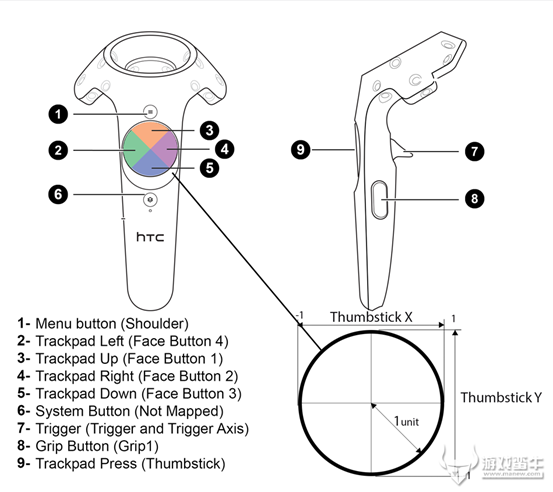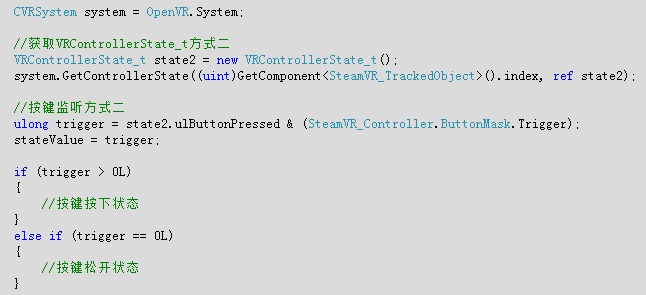标签:htc 手柄
一、HTC VIVE手柄按键图说明

1 - 菜单键
6 - 系统键(按下后手柄断开连接,再次按下手柄再次连接上)
7 - 扳机键
8 - 握持键
9 - 触摸板键
二、按键的监听方式
1、按键监听方式一:(SteamVR的方式,封装了OpenVR)
(1)点击触发:通过Device.GetPressDown / GetPressUp / GetPress获取按键事件
(2)触摸触发:通过device .GetTouchDown / GetTouchUp / GetTouch获取按键事件
2、按键监听方式二:(OpenVR的方式,偏底层)
通过controllerState.ulButtonPressed & (SteamVR_Controller.ButtonMask.Trigger)获取按键的按下、松开两种状态


或者:

注:m_State、m_PrevState分别表示:当前帧状态、前一帧状态
获取按下时,触摸板的值

获取松开时,触摸板的值(这里必须使用前一帧的状态,因为松开时,当前帧的触摸的值为0)

问题:按下时,没有获取到当前帧触摸板的值!
猜测原因:获取值的Update方法在更新状态Update的方法之前执行了,更新状态的Update方法执行后,才能获取触摸板的值
解决方法:如果不想修改脚本执行顺序的话,可以使用LateUpdate
触摸
适用于触摸板键
适用于扳机键(和点按类似,只是键程更短)
方式一:

方式二:

问题:触摸按下时,没有获取到当前帧触摸板的值!
原因:不明,内部机制需要搞清楚
解决办法:在触摸按下后的第二帧才获取到触摸板的值。

(3)触摸板轴的获取
通过以上两种方式获取的VRControllerState_t,获取触摸板的轴
x = state.rAxis0.x
y = state.rAxis0.y
三、代码使用总结如下
//检测手柄功能的脚本 这个脚本挂到手柄上(controller(right)和controller(left))上
public class HTCStick : MonoBehaviour {
//手柄
SteamVR_TrackedObject trackdeObjec;
void Awake ( ) {
//获取手柄上的这个组件
trackdeObjec = GetComponent<SteamVR_TrackedObject> ();
}
// Use this for initialization
void Start ( ) {
}
void FixedUpdate ( ) { //获取手柄输入
var device = SteamVR_Controller.Input ((int)trackdeObjec.index);
//以下是api中复制出来的按键列表
/* public class ButtonMask
{
public const ulong System = (1ul << (int)EVRButtonId.k_EButton_System); // reserved
public const ulong ApplicationMenu = (1ul << (int)EVRButtonId.k_EButton_ApplicationMenu);
public const ulong Grip = (1ul << (int)EVRButtonId.k_EButton_Grip);
public const ulong Axis0 = (1ul << (int)EVRButtonId.k_EButton_Axis0);
public const ulong Axis1 = (1ul << (int)EVRButtonId.k_EButton_Axis1);
public const ulong Axis2 = (1ul << (int)EVRButtonId.k_EButton_Axis2);
public const ulong Axis3 = (1ul << (int)EVRButtonId.k_EButton_Axis3);
public const ulong Axis4 = (1ul << (int)EVRButtonId.k_EButton_Axis4);
public const ulong Touchpad = (1ul << (int)EVRButtonId.k_EButton_SteamVR_Touchpad);
public const ulong Trigger = (1ul << (int)EVRButtonId.k_EButton_SteamVR_Trigger);
}
*/
//每种按键都有GetTouch、GetTouchDown、GetTouchUp、GetPressDown、GetPress、GetPressUp
//这里只有Trigger扳机键写了6种,其他的不再重复。
//Trigger的Touch触发条件是扳机键没有按到底,此时不会触发press。触发press时必定触发touch。
if (device.GetTouch (SteamVR_Controller.ButtonMask.Trigger)) {
Debug.Log ("轻按了扳机键");
//右手震动
//拉弓类似操作应该就是按住trigger(扳机)gettouch时持续调用震动方法模拟弓弦绷紧的感觉。
var deviceIndex2 = SteamVR_Controller.GetDeviceIndex (SteamVR_Controller.DeviceRelation.Rightmost);
device.TriggerHapticPulse (1200);
}
if (device.GetTouchDown (SteamVR_Controller.ButtonMask.Trigger)) {
Debug.Log ("轻按了扳机键");
}
if (device.GetTouchUp (SteamVR_Controller.ButtonMask.Trigger)) {
Debug.Log ("松开了扳机键");
//左手震动
var deviceIndex = SteamVR_Controller.GetDeviceIndex (SteamVR_Controller.DeviceRelation.Leftmost);
SteamVR_Controller.Input (deviceIndex).TriggerHapticPulse (3000);
//右手震动
var deviceIndex1 = SteamVR_Controller.GetDeviceIndex (SteamVR_Controller.DeviceRelation.Rightmost);
SteamVR_Controller.Input (deviceIndex1).TriggerHapticPulse (3000);
}
if (device.GetPressDown (SteamVR_Controller.ButtonMask.Trigger)) {
Debug.Log ("用press按下了trigger扳机键");
}
if (device.GetPress (SteamVR_Controller.ButtonMask.Trigger)) {
Debug.Log ("用press按了trigger扳机键");
}
if (device.GetPressUp (SteamVR_Controller.ButtonMask.Trigger)) {
Debug.Log ("用press松开了trigger扳机键");
}
//system键 圆盘下面那个键
// reserved 为Steam系统保留,用来调出Steam系统菜单 因此自己加的功能没用 下面的打印不会出现
if (device.GetTouchDown (SteamVR_Controller.ButtonMask.System)) {
Debug.Log ("按下了system系统按钮");
}
if (device.GetPressDown (SteamVR_Controller.ButtonMask.System)) {
Debug.Log ("用press按下了系统按钮");
}
//ApplicationMenu键 带菜单标志的那个按键(在方向圆盘上面)
//ApplicationMenu键 的Touch和Press没有区别,触发都要按下去
if (device.GetTouchDown (SteamVR_Controller.ButtonMask.ApplicationMenu)) {
Debug.Log ("按下了 ApplicationMenu菜单键");
}
if (device.GetPressDown (SteamVR_Controller.ButtonMask.ApplicationMenu)) {
Debug.Log ("用press按下了ApplicationMenu菜单键");
}
//Grip键 手柄两侧的按键 每个手柄左右各一且功能相同,同一手柄两个键是一个键。
//Grip键 的Touch和Press没有区别,触发都要按下去
if (device.GetTouchDown (SteamVR_Controller.ButtonMask.Grip)) {
Debug.Log ("按下了 Grip");
}
if (device.GetPressDown (SteamVR_Controller.ButtonMask.Grip)) {
Debug.Log ("用press按下了 Grip");
}
//Axis0键和Touchpad是等价的 与圆盘有关 详情看下面的TouchPad这里不再赘述
//触摸触发
if (device.GetTouchDown (SteamVR_Controller.ButtonMask.Axis0)) {
Debug.Log ("按下了 Axis0");
}
//按动触发
if (device.GetPressDown (SteamVR_Controller.ButtonMask.Axis0)) {
Debug.Log ("用press按下了Axis0");
}
//Axis1键 等价于Trigger键详情看上面的Trigger按钮 这里不再赘述
//触摸触发
if (device.GetTouchDown (SteamVR_Controller.ButtonMask.Axis1)) {
Debug.Log ("按下了Axis1");
}
//按动触发
if (device.GetPressDown (SteamVR_Controller.ButtonMask.Axis1)) {
Debug.Log ("用press按下了Axis1");
}
//Axis2键 目前未发现按键位置
//触摸触发
if (device.GetTouchDown (SteamVR_Controller.ButtonMask.Axis2)) {
Debug.Log ("按下了 Axis2");
}
//按动触发
if (device.GetPressDown (SteamVR_Controller.ButtonMask.Axis2)) {
Debug.Log ("用press按下了Axis2");
}
//Axis3键 目前未发现按键位置
//触摸触发
if (device.GetTouchDown (SteamVR_Controller.ButtonMask.Axis3)) {
Debug.Log ("按下了Axis3");
}
//按动触发
if (device.GetPressDown (SteamVR_Controller.ButtonMask.Axis3)) {
Debug.Log ("用press按下了Axis3");
}
//Axis4键 目前未发现按键位置
//触摸触发
if (device.GetTouchDown (SteamVR_Controller.ButtonMask.Axis4)) {
Debug.Log ("按下了Axis4");
}
//按动触发
if (device.GetPressDown (SteamVR_Controller.ButtonMask.Axis4)) {
Debug.Log ("用press按下了Axis4");
}
//Touchpad键 圆盘交互
//触摸触发
if (device.GetTouchDown (SteamVR_Controller.ButtonMask.Touchpad)) {
Debug.Log ("按下了 Touchpad");
//方法返回一个坐标 接触圆盘位置
Vector2 cc = device.GetAxis ();
Debug.Log (cc);
// 例子:圆盘分成上下左右
float angle = VectorAngle (new Vector2 (1, 0), cc);
Debug.Log (angle);
//下
if (angle > 45 && angle < 135) {
Debug.Log ("下");
}
//上
if (angle < -45 && angle > -135) {
Debug.Log ("上");
}
//左
if ((angle < 180 && angle > 135) || (angle < -135 && angle > -180)) {
Debug.Log ("左");
}
//右
if ((angle > 0 && angle < 45) || (angle > -45 && angle < 0)) {
Debug.Log ("右");
}
}
//按动触发
if (device.GetPressDown (SteamVR_Controller.ButtonMask.Touchpad)) {
Debug.Log ("用press按下了Touchpad");
Vector2 cc = device.GetAxis ();
Debug.Log (cc);
}
}
// Update is called once per frame
void Update ( ) {
}
//方向圆盘最好配合这个使用 圆盘的.GetAxis()会检测返回一个二位向量,可用角度划分圆盘按键数量
//这个函数输入两个二维向量会返回一个夹角 180 到 -180
float VectorAngle (Vector2 from, Vector2 to) {
float angle;
Vector3 cross = Vector3.Cross (from, to);
angle = Vector2.Angle (from, to);
return cross.z > 0 ? -angle : angle;
}
}
本文出自 “Unity_3D技术探讨” 博客,请务必保留此出处http://myselfdream.blog.51cto.com/9944020/1871170
标签:htc 手柄
原文地址:http://myselfdream.blog.51cto.com/9944020/1871170